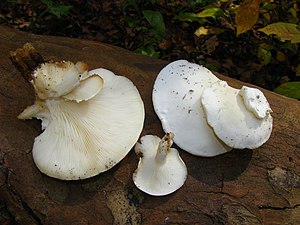Wooden funnels
| Wooden funnels | ||||||||||||
|---|---|---|---|---|---|---|---|---|---|---|---|---|

Powdered wooden funnel ( Ossicaulis lignatilis ) |
||||||||||||
| Systematics | ||||||||||||
|
||||||||||||
| Scientific name | ||||||||||||
| Ossicaulis | ||||||||||||
| Redhead & Ginns |
The wood funnellings ( Ossicaulis ) are a small genus of mushrooms from the Rasling family . These are sideways to funnel-like , whitish and often powdered lamellar mushrooms , which grow saprobion table on rotting wood and cause brown rot . They have a monomitic hyphae system and quite small, inamyloid spores.
The type species is the powdered wooden funnel ( Ossicaulis lignatilis ).
features
Macroscopic features
Species of the ossicaulis have attached, grown or slightly sloping lamellae and a stalk that has grown centrally or to the side of the hat and therefore look like sidewalls or funnel-shaped. The hat is between 2 and 12 cm wide, arched to spread flat or depressed. The dry surface is white to grayish in color and is often powdered. The white lamellae are relatively dense and the spore powder is white to cream-colored. The consistency of the meat ( trama ) can be soft to quite tough. There is neither a total envelope ( Velum universale ) nor a stem ring ( annulus ).
Microscopic features
The hyphae system is monomitic, i.e. it consists only of generative hyphae . The lamellar trama has a regular structure and there are buckles on the transverse walls of the fungal threads ( hyphae septa ) . The small, broadly elliptical to almost spherical spores show no color reaction (inamyloid) when iodine solution is added . The spur stands ( basidia ) also have buckles on their base. The hat skin ( Pileipellis ) is a clavicutis , which means that the lying hyphae are often branched (clavarioid) like the coral- shaped fruiting bodies of some clubs ( Clavaria ). At the edge of the lamellae, clumpy to branched sterile elements ( cheilocystidia ) are embedded in the fruit layer (hymenium) .
species
The genus consists of 2 species worldwide.
| Wooden funnels ( Ossicaulis ) worldwide |
Species delimitation
O. lachnopus has small spores (2.8-4.0 × 2.0-2.4 micrometers) and a gray or beige-gray tinted hat, whereas O. lignatilis has larger spores (4.0-5.6 × 2 , 4–3.2 µm) and a whitish to cream-colored hat, usually with a weak beige-grayish tone.
Ecology and diffusion
Both types are widespread in Europe; the powdered wooden funnel was also found in North America. O. lachnopus seems to have a tendency to grow in natural forest habitats. The species was first detected in Germany in 2013 in a small forest near Biederitz on the bark of a black poplar . On the other hand, O. lignatilis seems to prefer habitats that have been made or influenced by humans, such as cities, villages, parks and avenues. Several finds in Lower Austrian wine cellars are remarkable, where the species attacked wine barrels and caused brown rot in the wood. Wood funnels colonize dead and decaying wood from deciduous trees, rarely also from conifers.
Taxonomy
The genus was first described in 1985 and initially only included the powdered wooden funnel originally described by Christian Hendrik Persoon in 1801 as Agaricus lignatilis . Based on Italian collections, Marco Contu published a valid description of Ossicaulis lachnopus in 2007 . The independence of both species has been confirmed in recent studies (2013). Molecular genetic analyzes suggest that the wood funnellings are most closely related to the hermaphrodites ( Asterophora ), wood raslings ( Hypsizygus ), raslingen ( Lyophyllum ) and the genus Tricholomella - this is where the Schönkopf root was separated from the genus Calocybe .
Web links
Individual evidence
- ↑ a b c d e f Jan Holec, Miroslav Kolařík: Ossicaulis lachnopus (Agaricales, Lyophyllaceae), a species similar to O. lignatilis, is verified by morphological and molecular methods . In: Mycological Progress . tape 12 , no. 3 , August 2013, p. 589-597 , doi : 10.1007 / s11557-012-0866-2 .
- ^ A b Jens H. Petersen, Thomas Læssøe: About the genus Ossicaulis. In: MycoKey. Retrieved January 12, 2014 .
- ^ Paul M. Kirk, Paul F. Cannon, David W. Minter, JA Stalpers: Dictionary of the Fungi . 10th edition. CABI Europe, Wallingford, Oxfordshire 2008, ISBN 978-0-85199-826-8 , pp. 695 .
- ↑ Thomas Rauwald: Mushroom sensation in Biederitz. Collector discovered Ossicaulis lachnopus for the first time in Germany . In: Volksstimme.de . October 23, 2013, accessed January 12, 2014 .
- ^ Anton Hausknecht, Thomas W. Kuyper: A rare agaric mushroom on old wine barrels . In: Austrian journal for mushroom science . tape 1 , 1992 ( PDF on ZOBODAT ).
- ^ Scott Alan Redhead, James Herbert Ginns: A reappraisal of agaric genera associated with brown reds of wood . In: Transactions of the Mycological Society of Japan . tape 26 , no. 3 , 1985, pp. 349-381 .
- ↑ Marco Contu: Mushrooms of Sardinia: Notes and Descriptions – VII . In: Micologia e Vegetazione Mediterranea . tape 22 , no. 1 , 2007, p. 29–40 (Italian: Funghi della Sardegna: note e descrizioni – VII. ).
- ↑ Kuulo Kalamees: Tricholomella, a new genus, with the distribution data of Tricholomella constrictum, comb. nov. in east Europe and Asia . In: Persoonia . tape 14 , no. 4 , 1992, pp. 445-447 .
- ↑ P. Brandon Matheny and Judd M. Curtis, Valérie Hofstetter, M. Catherine Aime, Jean-Marc Moncalvo, Zai-Wei Ge and Zhu-Liang Yang, Jason C. Slot, Joseph F. Ammirati, Timothy J. Baroni, Neale L. Bougher, Karen W. Hughes, D. Jean Lodge, Richard W. Kerrigan, Michelle T. Seidl, Duur K. Aanen, Matthew DeNitis, Graciela M. Daniele, Dennis E. Desjardin, Bradley R. Kropp, Lorelei L. Norvell, Andrew Parker, Else C. Vellinga, Rytas Vilgalys, David S. Hibbett: Major clades of Agaricales: a multilocus phylogenetic overview . In: Mycologia . tape 98 (6) . Mycological Society of America, 2006, pp. 982-995 , doi : 10.3852 / mycologia.98.6.982 ( mycologia.org [PDF; 1.9 MB ]).